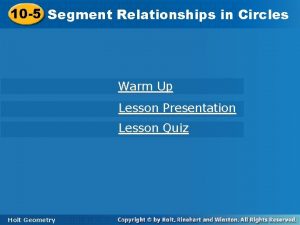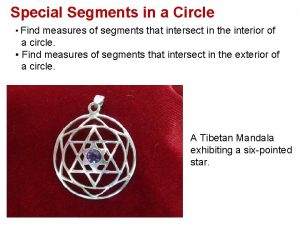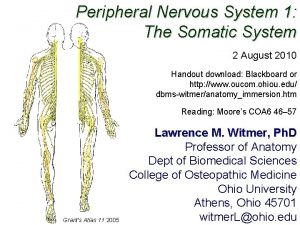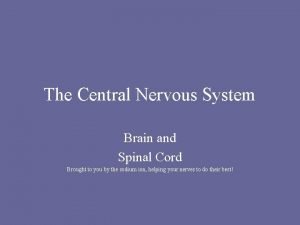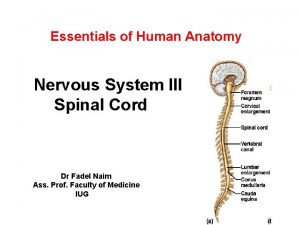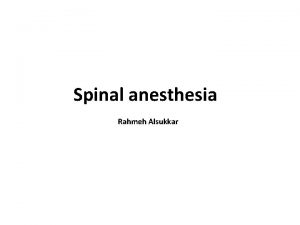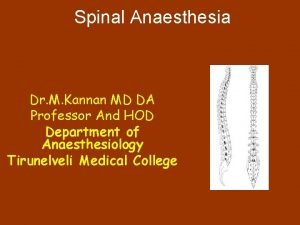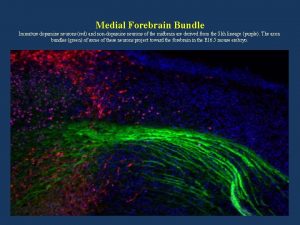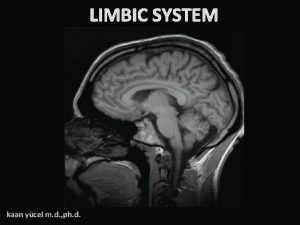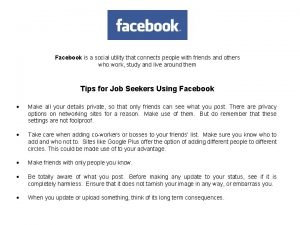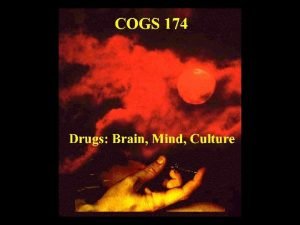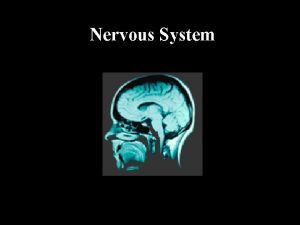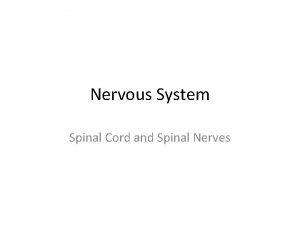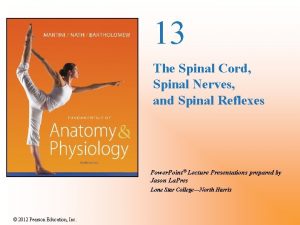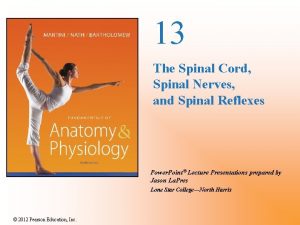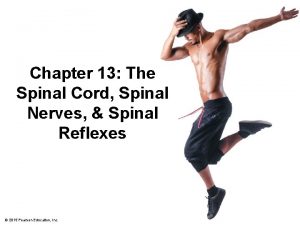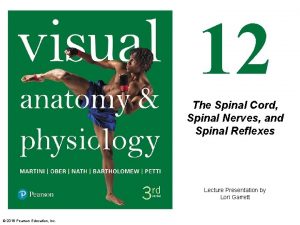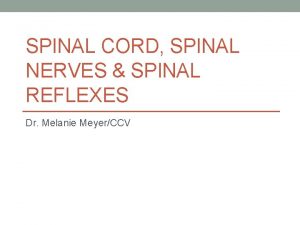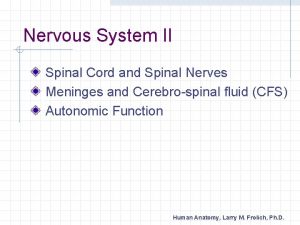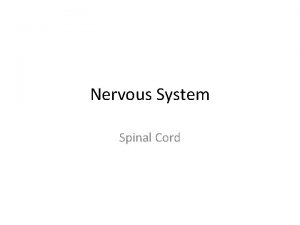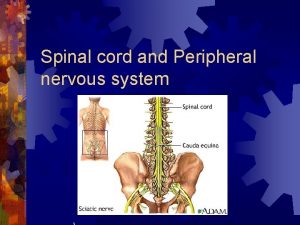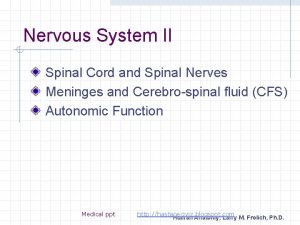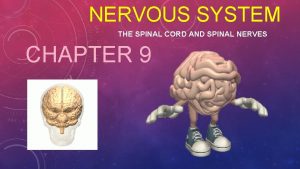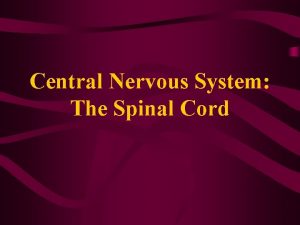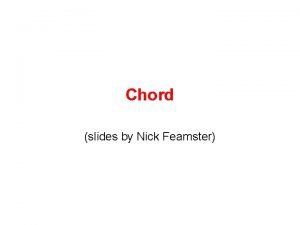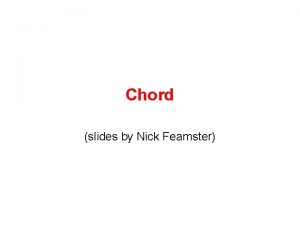Nervous System Structures Nervous Systems Spinal Chord Connects






























- Slides: 30

Nervous System Structures

Nervous Systems

Spinal Chord • Connects the brain and body. Also controls reflexes independently of the brain.

Brain • Embryros contain a forebrain, midbrain, and hindbrain that differentiate into the major brain parts.

Brain Stem • Brain stem – (mid brain) homeostasis, movement and conduction of information. • Medulla oblongata and Pons Transfers info from the PNS to the brain. Medulla coordinates large scale movements (running)per instruction from the upper regions and controls autonomic functions.



Brain Stem • Reticular formation – a network of neurons that filters information before it gets to the brain. • It determines whether or not you pay attention to incoming data. • Sleep is also controlled by the brain stem. Believed to help process learning and memory.


Cerebellum • Cerebellum – (hindbrain) controls movements and balance. Helps learn motor skills. • Double checks motor commands from the cerebrum. (hand eye coordination) • Receives hearing and visual input


Diencephalon • Diencephalon –(forebrain) epithalamus (pineal gland), thalamus, and hypothalamus • Thalamus – stores all information from the senses before sending them the cerebrum • Epithalamus – rhythms (sleep) • Hypothalamus – homeostasis (body temp)


Cerebrum • Cerebrum – main center of information processing • Cerebral cortex – outer layer of gray matter. Receives and processes info from the senses and somatosensory organs (pain, pressure, temp, muscles).

Cerebrum • Left and Right brain Hemepheres- each controls the opposite side of the body • Connected by axon called corpus callosum. • Lateralization – differences in the left and right • Left – better at math and logic • Right – better at recognition, patterns, and nonverbal thinking (creativity).


Cerebrum • • • Cerebral Cortex is separated into four lobes Frontal lobe – plans actions and movements Occipital lobe – visual processing Temporal lobe – Hearing and smelling Parietal lobe – speech, taste, reading



Neural plasticity • Neural plasticity – ability of the brain to change. • Synapses can be strengthened or weakened by frequency of use. • This leads to memory.


Sense receptors • Mechanoreceptors –pressure, touch, sound • Chemoreceptors – taste, smell, solute concentration • Electromagnetic receptors – light, electricity, magnetism • Thermoreceptors – detect hot and cold • Pain receptors – detects harmful conditions and solicits a reaction to minimize damage


Hearing and Equilibrium • Sound waves travel in the ear and vibrates the tympanic membrane which vibrates a bone called a stapes. • The stapes causes fluid in the cochlear duct to vibrate thus moving hairs in the cochlear duct. • The hairs sends signals to auditory nerves • Fluid in semicircular canal move hairs in response to gravity or out head tilting for equilibrium.


Taste Smell • Taste occurs when a receptor protein binds to a molecule and begin a transduction pathway that stimulates a taste nerve (chemoreceptor). • Smell (olfactory) – is all nerve cells that bind to a molecule and sends signals directly to the brain. (linning of the nose, mucus needed)



Vision • Light comes in the cornea (a fixed lens). The iris can dilate the pupil to control the amount of light that hits the flexible lens of your eye. • The retina contains photoreceptors that detect color in cones and black and white in rods (night vision). • The optic nerve carries visual input to the brain.

 Nada enharmonis yang tepat terdapat pada
Nada enharmonis yang tepat terdapat pada Segment relationships in circles
Segment relationships in circles Special segments of a circle
Special segments of a circle Brain and spinal cord nervous system
Brain and spinal cord nervous system Cns diagram
Cns diagram Spinal cord
Spinal cord Epineurium
Epineurium Lateral pectoral nerve
Lateral pectoral nerve Spinal cord structure
Spinal cord structure What are the characteristics of nervous tissue
What are the characteristics of nervous tissue Fundamentals of the nervous system and nervous tissue
Fundamentals of the nervous system and nervous tissue Processes neuron
Processes neuron Nervous sysytem
Nervous sysytem Spinal meninges and associated structures
Spinal meninges and associated structures Taylor's approach spinal
Taylor's approach spinal Spinal anaesthesia structures pierced
Spinal anaesthesia structures pierced Structures pierced during spinal anaesthesia
Structures pierced during spinal anaesthesia Analogous structure
Analogous structure Nervous system and digestive system
Nervous system and digestive system Endocrine system vs nervous system
Endocrine system vs nervous system Mechanism of action of hormones
Mechanism of action of hormones Adh function
Adh function What composed the upper parts of a sewing machine
What composed the upper parts of a sewing machine Bond between purine and pyrimidine
Bond between purine and pyrimidine What is a physical network topology
What is a physical network topology Forebrain
Forebrain Masteryconnect.com
Masteryconnect.com Limbic system
Limbic system Social utility that connects
Social utility that connects Medial forebrain bundle connects
Medial forebrain bundle connects Argument by analogy
Argument by analogy

